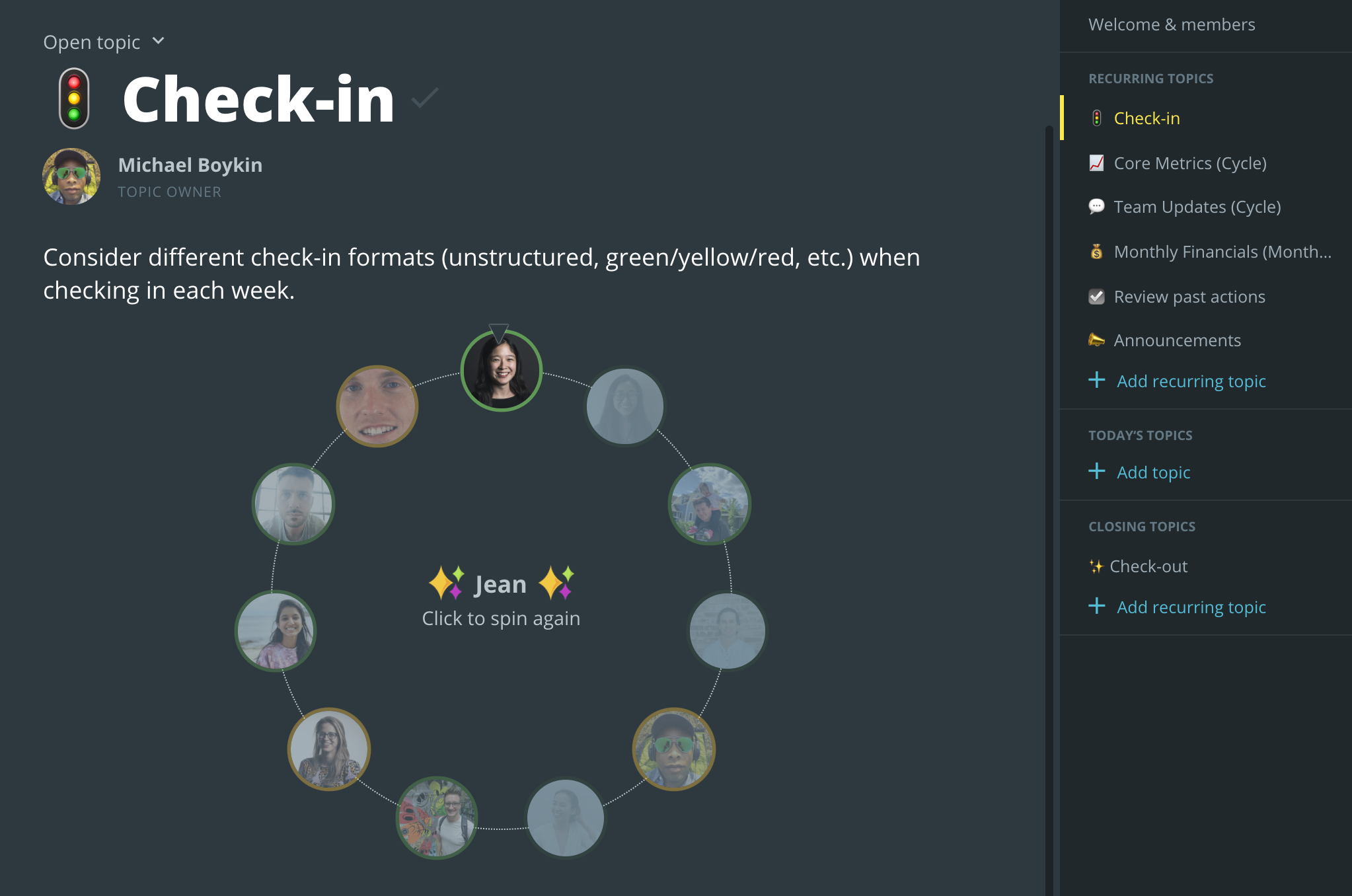You have 1 article left to read this month before you need to register a free LeadDev.com account.
Meetings are a perpetual pain point for folks, and yet, with many teams remote, it’s also the main way teams stay aligned and connected. How do you find meeting cadence, structures, and purposes that work for your team?
How engineers view meetings
Many years ago, I was just a few months into being a manager. I remember one morning waking up, looking at my calendar, and just feeling exhausted looking at the back-to-back meetings. So before my kids woke up, I opened up my work laptop – within twenty minutes or so, I had opened a few pull requests to delete unused code. Faced with a day of back-to-back meetings, I was desperate to feel some sense of accomplishment and productivity.
This is a really common way that engineers and engineers-turned-managers view meetings: when can they be over so I can have time to do my real work?!
But good meetings are important – they provide important touchpoints, create space for team connectedness, and allow for important discussions and alignment to take place.
Over the years, I’ve actually developed a passion for meetings, sharing tactical tips with others so that you don’t have to suffer through long and boring meetings anymore.
Let’s look at the different challenges people face when dealing with meetings.
Too many meetings
Let’s start with the basics – too many meetings lead to zoom fatigue, migraines, and general disengagement with work. In all-remote workplaces, we don’t even get the benefit of exercise and variety when moving to different conference rooms.
A recent poll I ran showed that 60% of folks actually have more meetings while remote, compared to in-office. Lacking the spontaneous hallway or lunchtime conversations, people are adding meetings to fill in the context they need to do their work.
Tip: Lean on asynchronous updates to create that ambient layer of context that you would get in a physical office. An easy guideline is to avoid using synchronous time for status updates – save synchronous time for team-building and things that require discussion. You can use asynchronous tools like Loom for video updates or Range for check-ins that replace your synchronous standups.
Aimless meetings
I’m sure you’ve all had the experience of being in a meeting that had an unclear agenda. Perhaps you’re 55 minutes into an hour-long meeting, but it feels like it might just keep going because 2 opinionated people got a bit carried away. Everyone else in the meeting sits quietly by, hoping that they manage to get back on track so they can finally leave.
Tip: Get clear on the purpose and structure of a meeting. Here’s a concrete example.
Every Monday morning, the team at Range has a weekly briefing with this explicit purpose: everyone in the company comes together to start the week off, review high-level metrics, and share important announcements.
The structure of the meeting looks like this:
- The facilitator plays music for the first five minutes as people join, finish making their coffee, etc.
- Opening – people share how they’re doing
- Review top-level company metrics – highlight anything notable
- Two-minute team updates from three top-level teams
- Open space for announcements and brief discussion topics
- Closing round with a prompt: what’s something you’re looking forward to this week? What’s something that’s been working well?
- Music and we play out
That’s it! This all only takes 25 minutes and is a welcome and brief start to the week.
Every single meeting we have at Range is similarly intentional in its purpose and structure. We run the meetings through Range’s meeting tool, which makes the facilitation super easy.

People are disengaged and don’t participate in meetings
I was talking to someone recently about his team’s standups, and how he might consider moving some of the status updates to asynchronous check-ins. His main concern was that if they did that, what would some of the quieter team members have to say when they did meet synchronously? How would they contribute to the conversation?
Especially remotely, it’s easy to check out during meetings, to put yourself on mute and turn off your video, to browse or do other work on your second monitor. But this defeats the purpose of making the most of valuable synchronous time.
Tip: Start and end meetings with opening and closing rounds. Research shows that if people say something at the beginning of a meeting, they are more likely to contribute to the rest of the meeting. This participation is even more important remotely, when most interactions are scheduled, and there are no serendipitous lunchtime convos.
We also have easy icebreaker questions that we use with a spinner to build team connection. Questions might look something like, ‘What favorite snack would you want in stock in an office kitchen?’ or ‘What’s a useful piece of feedback you’ve received?’ If the default is to only talk about the immediate work at hand, this can honestly feel awkward at first. But when you push past the awkwardness, you’ll benefit from increased team engagement and connectedness.
Meetings take over your calendar
It’s not just the amount of time in meetings, but how they are distributed throughout your week and interrupt your valuable focus time.
We used to have our twice-a-week Product Collaboration meeting on Tuesdays and Thursdays at 1pm Pacific time. I personally found that it was right in the middle of a nice juicy chunk of focus time. Maybe it’s just me, I thought.
But when I raised it with the team, it turned out that everyone preferred for the meeting to be earlier in the day – so we moved it, freeing up a large chunk of focus time for the product and engineering teams.
Tip: Defrag your calendar. Zoom out and think about the cadence of meetings for an individual over a week or two. When is best for you to do focused work? Let me give you a really concrete example of someone on our team.
Stephanie is an engineer on the Range team. Every Monday morning she meets with the entire Range team for the weekly briefing. The first week of each cycle, she also participated in her team’s cycle planning on Mondays. On Thursdays, she has an hour of Product Collaboration time, where people across teams bring demos for feedback and topics for discussions. That meeting often ends 30 minutes early, and we end up playing Scattergories, or drawbattle.
If she wants to have more social time with coworkers, there is also an optional 30-minute Tuesday and Friday social game. The two-week cycle ends with a 1.5-hour structured full-team recap, which includes personal reflections, celebrations, founder thoughts, and Q&A.
Stephanie also has a few biweekly 1:1s that she’s scheduled all for the first week of the two-week cycle to defrag her calendar so that the second week, she has more focus time.
Don’t let meetings just happen to you – encourage folks on your team to take control of their schedule and defrag it, moving things around to make focus time for themselves. Model this behavior yourself, and schedule recurring ‘No meetings: focus time’ blocks in your own calendar.
Be impatient
You may not always feel like you have the ability to change how meetings are run. I used to be in a weekly cross-functional multi-team coordination meeting that had a really unclear purpose. There were a lot of people more senior than I was, and so for many months, I endured it – until finally, I couldn’t stand it any longer. I drafted and shared a suggested purpose and structure for the meeting. The response surprised me. People were incredibly appreciative that I had put the work and thought into improving the meeting.
From that, and subsequent experiences, I learned that everyone really despises inefficient meetings. They feel the tension of time poorly spent deep in their bodies as it unfolds. Even the people who seem to be intentionally hijacking the meetings are actually thankful when you cut them off, create some structure, and make it easier for them to stay on track.
I used to think that one of my worst qualities was that I was impatient. But over the years, I’ve found that my impatience is also a superpower. It lets me be that person who speaks up and says:
Can we do this asynchronously? Can you two take this discussion offline? Can we make this meeting shorter or merge it with another meeting?
So go forth, and for your sake and your team’s, reduce your overall meeting time – and make sure that the time you do spend in meetings is intentional and well-spent.




